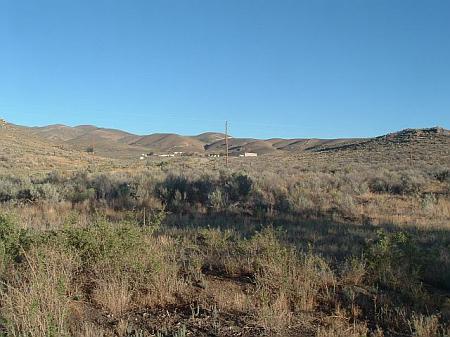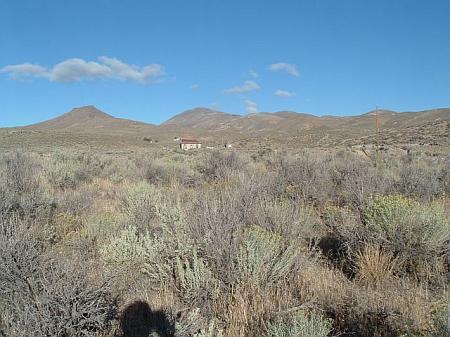10.0 Contact
10.1 Risk and Hazard Assessment
The small community of Contact is located in northern Elko County along Highway 93 and east of Salmon Falls Creek. Contact is located at approximately 5,560 feet in elevation. The population of Contact has traditionally been small since it’s beginning as a mining town in 1887. The community hazard assessment resulted in rating Contact in the High Hazard category (75 points). A summary of the factors that contributed to the rating is included in Table 10-3. The primary factors that contributed to the high rating were poor access, inadequate address signage, inadequate defensible space, lack of water for fire suppression, and no local fire department. The community boundary identified for this report s shown in Figure 10-1.
10.1.1 Community Design
The wildland-urban interface area around Contact is an intermix condition. There is no clear line of demarcation between structures and wildland fuels. Eleven homes included in the assessment. Eight of the homes are on parcels of one to ten acres in size, with the remainder on lots that are one acre or less.
- Access: Highway 93 and Old Highway 93 are the major transportation routes through Contact. The highways are paved; the secondary roads are at least twenty feet wide, dirt, and have adequate turnaround space for fire suppression equipment.
- Signage: Street signs in the community are clearly posted on three of the four community roads. Addresses are not clearly visible on any of the homes observed. Clear and visible street signs and residential addresses are important in locating homes during low visibility conditions that occur during a wildfire.
- Utilities: All of the utilities are above ground. Power line corridors need proper maintenance to minimize wildfire damage to electric utilities and reduce the possibility that sparks could start a fire in adjacent vegetation.
10.1.2 Construction Materials
All of the homes observed in the interface area were built with non-combustible or highly fire resistant siding material such as medium density fiberboard. Only two homes were not constructed with fire resistant roofing materials such as composition, metal, or tile. Two of the homes had unenclosed porches, decks, or balconies that can create drafts and provide areas where sparks and embers can lodge, smolder, ignite, and rapidly spread fire to the home.
10.1.3 Defensible Space
Over one-third of the homes observed in the interface did not meet the minimum recommended defensible space requirement to help protect the home from damage or loss during a wildfire.
10.1.4 Suppression Capabilities
Wildfire Protection Resources
Contact has no organized fire department. The area is protected by the Jackpot and Wells Volunteer Fire Departments and BLM automatic dispatch from Wells. Table 10-1 lists the local wildfire resources and equipment available for initial response to Contact in the event of a reported wildfire. Additional resources are available from local, state, and federal agencies through mutual aid agreements as described in Section 4.1.1.
| Type of Equipment | Amount of Equipment | Cooperating Partner (Resource Location) |
|---|---|---|
| Type 3 Engine Type 2 Engine Type 1 Engine Type 6 Engine |
2 1 1 1 |
Jackpot VFD (Jackpot) |
| Type 2 Engine | 1 | Wells VFD (Wells) |
| Type 6 Engine | 1 | Nevada Division of Forestry (Wells - Seasonal) |
| Type 4 Engine | 1 | Bureau of Land Management (Wells) |
| Source: Sam Hicks, Nevada Division of Forestry Elko County Prevention Captain; Verl Jarvie, Jackpot VFD Chief. | ||
Water Sources and Infrastructure
There was no designated water source for fire suppression. Water may be available for drafting from local ponds and streams.
10.1.5 Factors Affecting Fire Behavior
The community lies within a north-south canyon along US Highway 93. The terrain within the community boundary is gently rolling with slopes of eight to twenty percent. The prevailing wind direction is from the south and southwest and there is a history of afternoon thunderstorms and dry lightning strikes in the area. Dense vegetative fuels in the interface area were estimated at two to four tons per acre and considered a high fuel hazard. Fuels in the community consist primarily of annual mustard, cheatgrass, perennial grasses, big sagebrush, rabbitbrush, and greasewood. Cheatgrass growth is dependent on annual moisture and will produce increased fuel volumes in years of higher than average precipitation and can significantly increase the fuel load and fuel continuity. The fuel loading in the riparian areas was heavy, estimated at four to six tons per acre, comprised mostly of willow and Russian olive. Due to higher moisture levels found in riparian soils and vegetation, the fuel hazard in the riparian area was considered low. Fuel hazard mapping in the interface areas around Contact is shown in Figure 10-2. Fuel hazard photo points are included in Figure 10-3.
10.1.6 Fire Behavior Worst Case Scenario
The worst-case scenario for a wildfire in the area surrounding Contact would be a dry lightning storm on a late summer afternoon during a year of normal to above normal precipitation and high annual grass and forb production. Multiple fire ignitions to the south and west of community and strong erratic winds from thunderstorms could rapidly push a fire into the community.
10.1.7 Ignition Risk Assessment
Contact has a high risk of ignition based on fire history in the area and the potential for increased fuel loading from annual grasses in high precipitation years. The record of historic fires on the surrounding public land shows a moderate level of ignition potential, however lighting strikes in the vicinity are not uncommon. The primary risk of ignition in Contact is lightning, although human caused ignitions are unpredictable and can occur at any time.
10.2 Risk and Hazard Reduction Recommendations
The responsibility to keep a community fire safe falls not only on the local fire protection district but also on the residents and local governments. The recommendations for the Contact area focus primarily on the ongoing and additional efforts to create and maintain defensible space and on community coordination and public education efforts that could be undertaken to enhance fire safety.
10.2.1 Defensible Space Treatments
Defensible space treatments are an essential first line of defense for residential structures. The goal of the treatments is to significantly reduce or remove flammable vegetation within a prescribed distance from structures. (Refer to Appendix E for the minimum recommended defensible space area). Defensible space reduces the fire intensity and improves firefighter and homeowner chances for successfully defending a structure against oncoming wildfire.
Property Owners Recommendations
- Remove, reduce, and replace vegetation around homes according to the guidelines in Appendix E. This area should be kept:
- Lean: There are only small amounts of flammable vegetation.
- Clean: There is no accumulation of dead vegetation or other flammable debris.
- Green: Existing plants are healthy and green during the fire season.
- Store woodpiles a minimum distance of thirty feet from any structure.
- Remove all dead vegetation and other flammable materials a minimum of five feet from the exterior of the structure.
- Where cheatgrass has become dominant within the defensible space zone, areas should be mowed prior to seed maturity or treated with an application of a pre-emergent herbicide. Treatments may need to be repeated for several years to ensure that the seed bank of unwanted annual grass seeds has been depleted. Refer to Appendix E for a recommended seed mixture and planting guidelines that can be used in conjunction with cheatgrass removal.
- Mow or remove brush growing against fences in the community. The minimum distance for clearance should be ten feet in grass and 25 feet in brush.
- Maintain areas under wood decks and porches free of weeds and other flammable debris. Enclose these areas when possible. Box in eves and cover attic and other ventilation openings with very fine metal wire mesh to prevent embers from entering the attic or crawl space.
- Replace wood shake roofs with fire resistant materials such as metal, tile, or composition.
- Clear all vegetation and combustible materials around propane tanks for a minimum distance of ten feet.
- Install spark arrestors on chimneys.
- Prune limbs from fir trees to a height of fifteen feet, but not more than one-third the height of the total tree height. Prune limbs from juniper trees to a minimum height of four feet from the ground, but not more than one-third the total tree height. Pruning should be completed to reduce ladder fuels on all deciduous and coniferous trees within the defensible space zone. Prune all dead and diseased branches.
- Prune all tree branches to a minimum distance of fifteen feet from buildings, paying special attention around chimneys.
- Immediately dispose of cleared vegetation when implementing defensible space treatments. This material dries quickly and poses a fire hazard if left on site.
- Maintain the defensible space as needed.
10.2.2 Fuel Reduction Treatments
Fuel reduction treatments are applied on a larger scale than defensible space treatments. Permanently changing the fuel characteristics over large blocks of land to one of a lower volume and one of altered distribution reduces the risk of a catastrophic wildfire in the treated area. Reducing vegetation along roadways and driveways could reduce the likelihood of blocking access and escape routes, help contain the fire perimeter, and improve firefighter access and safety for protecting homes.
Elko County Roads Department and Nevada Department of Transportation
- Reduce vegetation and maintain roads by mowing all vegetation to a height of no more than four inches for a distance of twenty feet from the edge of the road on both sides of the road. Remove and dispose of biomass at an appropriate site. Reseed treated areas with fire resistant species such as recommended in Appendix E to minimize cheatgrass and noxious weed invasion.
Utility Company
- Reduce and remove vegetation to maintain clearance around power lines. Clear vegetation within fifteen feet of utility poles near the community.
10.2.3 Fire Suppression Resources
Elko County and Nevada Division of Forestry
- Install a minimum capacity 10,000-gallon water tank in the community for fire suppression.
10.2.4 Community Coordination
Property Owners
- Form a local community-based organization to take responsibility and provide leadership for community-wide fuels reduction and community fire safety. The Nevada Fire Safe Council is one option for community organization. Through the establishment of a local Nevada Fire Safe Council Chapter, local communities will become part of a large network for sharing information, including notification of programs and funding opportunities for fire mitigation projects such as those listed in this report. The Nevada Fire Safe Council will accept and manage grants and contracts on the Chapter’s behalf through its non-profit status. The Nevada Fire Safe Council will provide assistance and support to communities to complete fire safe plans, set priorities, educate and train community members, and promote success stories of its members. To form a local chapter or for more information contact the:
Nevada Fire Safe Council
210 South Roop Street Suite 101
Carson City, NV 89701
www.nvfsc.org - Ensure residential addresses are easily visible from the road. Address characters should be at least four inches high, reflective on a dark background, and made of non-flammable material. Improving visibility of addresses will make it easier for those unfamiliar with the area to navigate under smoky conditions during a wildfire.
10.3 Summary of Recommendations
| Involved Party | Recommended Treatment | Recommendation Description |
|---|---|---|
| Property Owners |
Defensible Space | Remove, reduce, and replace vegetation around homes according to the guidelines in Appendix E. Maintain the defensible space annually. |
| Community Coordination | Ensure residential addresses are easily visible from the road. Form a local community-based organization to provide leadership and be responsible for community-wide fuels reduction and community fire safety. |
|
| Elko County Nevada Department of Transportation |
Fuels Reduction | Reduce vegetation and maintain roads by mowing all vegetation to a height of no more than four inches for a distance of twenty feet from the edge of the road on both sides of the road. Remove and dispose of biomass at an appropriate site. |
| Utility Company | Fuels Reduction | Reduce and remove vegetation to maintain clearance around power lines. Clear vegetation within fifteen feet of utility poles near the community. |
| Elko County Nevada Division of Forestry |
Fire Suppression Resources | Install a minimum capacity 10,000-gallon water tank in the community for fire suppression. |
Table 10-3Contact Wildfire Hazard Rating Summary |
 |
Figure 10-1Contact Fire History |
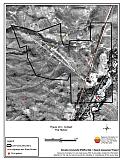 |
Figure 10-2Contact Classification of Fuel Hazard |
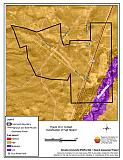 |
Figure 10-3. Contact Fuel Hazard Photo Points
Photo Point 1. 4626644N, 686720E, 280°NW. Fuels west of the NDOT maintenance station consist of annual mustard, cheatgrass, perennial grasses, and a shrub layer of sagebrush and greasewood that is two to four feet high. Fuel loading was estimated at two to four tons per acre and was considered a high fuel hazard.
Photo Point 2. 4627297N, 686774E, 280°NW. Fuels in the interface area are typically dominated by sagebrush and rabbitbrush shrubs two to four feet tall with a fine fuel component of cheatgrass and perennial grasses.

